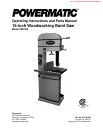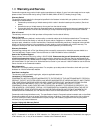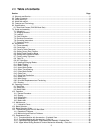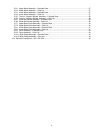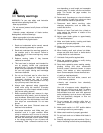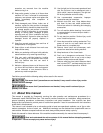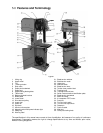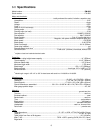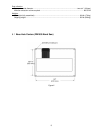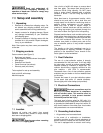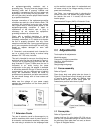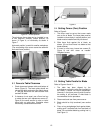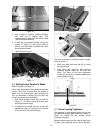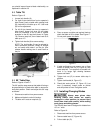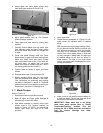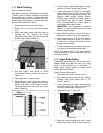
5
3.0 Safety warnings
WARNING: For your own safety read instruction
manual before operating Band Saw.
- Wear eye protection.
- Do not remove jammed cutoff pieces until blade
has stopped.
- Maintain proper adjustment of blade tension,
blade guides, and thrust bearings.
- Adjust upper guide to just clear workpiece.
- Hold workpiece firmly against table.
1. Read and understand entire owner's manual
before attempting assembly or operation.
2. Read and understand the warnings posted on
the machine and in this manual. Failure to
comply with all of these warnings may cause
serious injury.
3. Replace warning labels if they become
obscured or removed.
4. This band saw is designed and intended for
use by properly trained and experienced
personnel only. If you are not familiar with the
proper and safe operation of a band saw, do
not use until proper training and knowledge
have been obtained.
5. Do not use this band saw for other than its
intended use. If used for other purposes,
Powermatic disclaims any real or implied
warranty and holds itself harmless from any
injury that may result from that use.
6. Always wear approved safety glasses/face
shield while using this machine. (Everyday
eyeglasses only have impact resistant lenses;
they are not safety glasses.)
7. Before operating band saw, remove tie, rings,
watches and other jewelry, and roll sleeves up
past the elbows. Remove all loose clothing and
confine long hair. Non-slip footwear or anti-skid
floor strips are recommended. Do not wear
gloves.
8. Keep work area clean. Cluttered areas and
benches invite accidents.
9. Use proper extension cord. Make sure your
extension cord is in good condition. When
using an extension cord, be sure to use one
heavy enough to carry the current your product
will draw. An undersized cord will cause a drop
in line voltage resulting in loss of power and
overheating. Table 1 shows the correct size to
use depending on cord length and nameplate
ampere rating. If in doubt, use the next heavier
gage. The smaller the gage number, the
heavier the cord.
10. Secure work. Use clamps or a vise to hold work
when practical. It’s safer than using your hand
and it frees both hands to operate tool.
11. Disconnect tools before servicing; when
changing accessories, such as blade, bits,
cutters and the like.
12. Direction of feed: Feed work into a blade or
cutter against the direction of rotation of the
blade or cutter only.
13. Adjust upper blade guides to approximately
1/8” above workpiece.
14. Make sure blade tension, tracking and blade
guides are all properly adjusted.
15. Make relief cuts where possible, when cutting
curved stock.
16. When feeding small work pieces into blade,
always use push stick, fixture, or similar device
to keep hands at a safe distance.
17. Hold stock firmly and flat against table.
18. Wear ear protectors (plugs or muffs) during
extended periods of operation.
19. Some dust created by power sanding, sawing,
grinding, drilling and other construction
activities contain chemicals known to cause
cancer, birth defects or other reproductive
harm. Some examples of these chemicals are:
•
Lead from lead based paint.
•
Crystalline silica from bricks, cement and
other masonry products.
•
Arsenic and chromium from chemically
treated lumber.
Your risk of exposure varies, depending on
how often you do this type of work. To reduce
your exposure to these chemicals, work in a
well-ventilated area and work with approved
safety equipment, such as face or dust masks
that are specifically designed to filter out
microscopic particles.
20. Do not operate this machine while tired or
under the influence of drugs, alcohol or any
medication.
21. Make certain switch is in OFF position before
connecting machine to power supply.
22. Make certain machine is properly grounded.
23. Do not back stock out of blade while blade is
running.
24. Remove adjusting keys and wrenches. Form a
habit of checking to see that keys and adjusting



